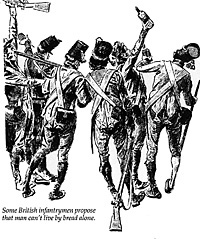
Back in EE&L #6. page 8, the importance of bread in the Napoleonic soldier's diet was covered. I have received several requests for a bread recipe.
Let me point out that bread was made of flour and water, fermented, then baked. But originally, cereal meal was used in the place of flour, gradually to be replaced by a kind of cake made out of a mixture of flour, honey, oil, sweet wine, various grains, fruits and meat.
The Hebrews, the Egyptians, and the Chinese introduced flat cakes made of a dough of flour and water and baked without leaven. No doubt on many occasions the Napoleonic soldier was reduced to eating this kind of unleavened bread. The discovery of leaven bread is attributed to the Egyptians, who used the leaven of sourdough, left over from the previous bread making.
The use of fermented bread spread very quickly but did not supersede immediately the old method of making unleavened flat cakes, which were the only bread known to Roman soldiers. However, by the Napoleonic period, fermented bread was almost universally used, at least in Europe.
Here is a fairly simple recipe for French bread:
4 1/2 cups (1 1/2 lb. or 680 grams) high-gluten bread flour (preferably unbleached)
2 teaspoons of kosher salt
1 tablespoon instant dry yeast
2 teaspoons of sugar (optional)
1. Place 1/2 cup of flour, the yeast, the sugar and 1/2 cup of warm water (not hot, it would kill the yeast) in the mixing bowl and mix. Allow to stand for about 10 minutes.
2. Add the remaining flour and salt to the above mixture, and with the food processor fitted with a plastic blade for dough, start the machine slowly. Then pour in slowly about 10 ounces of cold water. Mix until the dough forms a sticky ball. Let rest for 5 minutes.
3. Then mix again until the dough warms slightly (about 2 to 5 minutes). Do not overmix, the friction will cause the dough to overheat and the yeast will die.
4. Transfer the dough into a bowl (I use a ceramic bowl) and cover it with plastic wrap. (In the winter, I place the bowl in a warm oven preheated for less than 5 minutes at 200° F.) Let it rise for 3 to 6 hours (the longer the bread rises the better it will taste).
5. Then punch the dough down and divide it into three pieces. Roll each one into a thick loaf and place on a floured baking tray. (I cover my tray with aluminum foil and flour the aluminum foil. After the bread is baked, I simply discard the aluminum foil leaving the tray virtually clean.) Cover and let rise again for 1 or 2 hours, until the dough is well puffed.
6. Preheat the oven to 450º F.
7. Just before baking, sprinkle the loaves with flour. On top of each one, make four parallel diagonal slashes with a sharp knife or a razor blade.
8. Place the bread in the oven and throw about 1/2 cup of water at the bottom of the oven to create steam (that makes a crusty bread). Bake for 30 to 35 minutes throwing a bit more water (2 tablespoons) into the baking. Test for doneness by tapping the top of each loaf (be careful not to burn yourself). A hollow sound means it is baked through. Remove and cool on a wire rack.
Recipe Notes:
The sugar will give the bread the familiar light golden-brownish color of bread. If the sugar is omitted, the crust will be white.
Making the bread is a lengthy procedure but the result is well worth the effort. I start very early in the morning, so the fresh bread can be ready for dinner in the evening. You can also freeze the bread but there is nothing like fresh bread. I usually make the above recipe twice and freeze what we don't use the first day.
If you don't have a food processor you can knead the bread by hand.
More Leona's Corner:
Back to Empires, Eagles, & Lions Table of Contents #12
Back to Empires, Eagles, & Lions List of Issues
Back to MagWeb Master Magazine List
© Copyright 1995 by The Emperor's Press
[This article appears in MagWeb (Magazine Web) on the Internet World Wide Web.
Other military history articles and gaming articles are available at http://www.magweb.com]